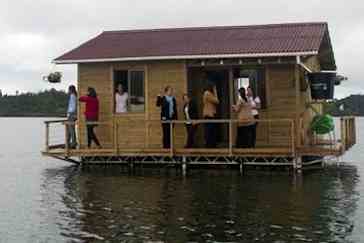
Instead of bringing the water to our homes, why not bring our homes to the water? Especially at a time when rising sea levels threaten the flooding of some of the world’s greatest cities?
Aquatecture is a fundamentally new reappraisal of how we co-exist with the sea and rivers. Leading exponents include Baca Architects, London. Their first domestic project went on site last month.
The Netherlands, which The Washington Post sees as “the world’s premier lab for how to tame rivers and seas,” is also at the forefront of building “amphibious houses,” which are designed to adapt and respond to rising sea levels.
As architect Haiko Cornelissen points out, during times of flooding, each amphibious house is “able to float on the water, held in place by guides, and continues to function thanks to flexible utilities. The amphibious house is more a new type of construction than a new type of house.” If you’d like, you can even make them solar-powered, and live completely off the grid. Or, consider the cool concepts from WaterStudio.NL for waterfront living: floating villas, floating hotels, floating mosques, heck, even floating golf courses.
And, it’s not just the Dutch who are coming up with creative ideas for new living arrangements in the post-Sandy area. As part of design competitions hosted in the months after Superstorm Sandy hit, there have been numerous concepts for innovative housing that would respond to a Superstorm. Inhabitat recently featured six smart, flood-resistant homes. One of the neatest ideas is something the designer is calling Shut Up the House – it’s a beachfront home that converts into a tiny, folded wooden box until the storm passes over. And Rebuild by Design just unveiled 10 new innovative concepts for protecting waterfront communities.
But amidst all this fine talk, lets not forget the humble houseboat – moored on a canal or even a river – its a very low-tech solution to many existing urban housing problems.
One Response
I have lived in a float cabin on a lake for several years now. My cabin is remote and can only be accessed by a 25 minute boat ride. We have a widely spread community on our lake, but most cabins are used only in summer. We live in our about 75% of the year in all seasons. I wouldn’t trade it for anything. You can read more about it at my blog link. – Margy